Bible Verse Meaning of John 11:44
Verse: "And he that was dead came forth, bound hand and foot with graveclothes: and his face was bound about with a napkin. Jesus saith unto them, Loose him, and let him go." - John 11:44 (KJV)
Overview
The passage of John 11:44 captures a pivotal moment in the New Testament, where Jesus raises Lazarus from the dead. This particular event is rich in theological significance, showcasing Jesus' power over death and foreshadowing His own resurrection.
Bible Verse Interpretations
Public domain commentaries provide valuable insights into the meaning and implications of this verse:
- Matthew Henry: He emphasizes the miracle as a demonstration of Christ's divinity. The fact that Lazarus, who was undeniably dead, could come forth illustrates Christ's authority over life and death. The raising of Lazarus served not only as a miracle for Lazarus and his sisters but also as a sign to all witnesses of Christ's power, leading many to believe in Him.
- Albert Barnes: Barnes notes the imagery of Lazarus still being bound by graveclothes as a representation of the former state of the believer. He interprets this as not just a physical resurrection, but also a spiritual awakening, shedding the old self and being called into new life. The command to "Loose him, and let him go" signifies the freedom believers gain through Christ.
- Adam Clarke: Clarke focuses on the instructions given after the miracle. He indicates that while Jesus was the source of life, humanity has a role in the process of restoration. The idea of unbinding Lazarus symbolizes the responsibility of the community of believers to assist one another in the journey of faith and spiritual growth.
Spiritual Insights
This verse speaks profoundly to how Jesus interacts with death, sin, and salvation:
- It shows that death is not the final chapter for a believer; through Christ, there is hope for resurrection.
- This event reflects the transformational journey from death to life, akin to spiritual rebirth.
- It serves as a reminder of the communal aspect of faith where believers are called to support each other in loosening the binds of sin and despair.
Historical Context
Understanding the context surrounding this event is crucial in biblical exegesis:
- Lazarus was a close friend of Jesus, and his death was a profound loss for Jesus and his sisters, Martha and Mary.
- The miracle took place in Bethany, which was a significant location, reflecting both the personal and communal impact of Jesus' ministry.
- This event took place shortly before Jesus' own crucifixion, amplifying its foreshadowing of the resurrection and encouraging belief in His eventual triumph over death.
Application in Daily Life
How can John 11:44 be understood and applied today?
- Recognize the areas of life that may feel dead or hopeless; seek Jesus for renewal and restoration.
- Understand the importance of community in spiritual growth and healing; be willing to help and encourage others.
- Reflect on the significance of Jesus’ power over death as a motivator for sharing the gospel and spreading hope.
Cross References
This verse connects beautifully to several other scriptural passages that resonate with similar themes:
- John 14:6: "Jesus saith unto him, I am the way, the truth, and the life: no man cometh unto the Father, but by me."
- Romans 8:11: "But if the Spirit of him that raised up Jesus from the dead dwell in you, he that raised up Christ from the dead shall also quicken your mortal bodies by his Spirit that dwelleth in you."
- Revelation 1:18: "I am he that liveth, and was dead; and, behold, I am alive for evermore, Amen; and have the keys of hell and of death."
Final Thoughts
This Bible verse commentary on John 11:44 illustrates not only the miraculous event but also the deeper implications for belief, community, and the inexorable power of Jesus over life and death. As one studies this verse, it invites the reader to contemplate their own faith journey, encouraging a deeper understanding of Scripture, and enriching their biblical study insights.


